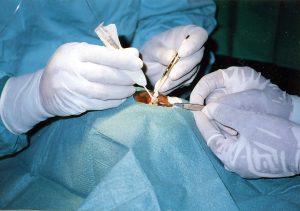About the surgery
For many thyroid disorders, surgery is the best treatment with the help of thyroid surgical instrument set. Thyroid surgery is one of the most widely performed surgical procedures in Europe. There are several surgical options, and your surgeon will discuss with you what type of procedure is best for you.
What is thyroid surgery?
Traditional surgery
Thyroid surgery is usually done through a 2-8 cm incision in the skin of the lower neck and under general anesthesia. The surgeon removes all or part of the thyroid gland. The incision is usually made in the skin fold of the neck, which makes it less visible.
Minimally invasive surgery
There are now alternatives to traditional surgery for thyroid pathologies. With minimally invasive surgery, the surgeon performs the operation through one or two very small incisions. Unlike the traditional method described above, the minimally invasive approach leaves only a tiny scar.
About traditional thyroid surgery
When the amount of tissue to be removed is too much, or if the procedure is likely to be complex, the surgeon uses traditional thyroid surgery.
What is that?
Traditional thyroid surgery is usually done through a 2-8cm incision in the skin on the lower neck. The surgeon pulls apart the skin and muscles to expose the thyroid gland. The incision is usually made in the skin fold of the neck, which makes it less visible. The flow of blood to the gland is interrupted and the surgeon removes all or part of the gland.
During the procedure, the surgeon tries to locate and respect the nerves ending in the larynx or the vocal cords which are just behind the thyroid gland. Damage to these nerves can seriously affect the ability to speak, swallow or breathe. Using a monitoring system can help the surgeon locate these nerves, monitor them, and confirm that they were not injured during the procedure.
The surgeon also takes care to locate and respect the four small parathyroid glands located next to the thyroid gland. These four small glands secrete a hormone called parathyroid hormone which regulates the level of calcium in the blood.
Benefits and risks
The main benefit of thyroid surgery is that it should relieve some or all of your symptoms.
Be sure to ask your doctor for a detailed explanation of the benefits and risks of surgery and their experience. As with any surgical operation, certain complications can arise during or after thyroid surgery:
Scar: There will be a scar which will usually fade into a thin line resembling a wrinkle on the neck. But the healing may not go as well as you would expect and the scar may be more pronounced than expected. There may also be loss of sensation in the skin that has been ruled out by the surgeon to properly visualize the thyroid.
Thyroid hormone replacement therapy: Depending on the extent of the ablation, you may need thyroid hormone replacement therapy after the operation.
Hypoparathyroidism: The parathyroid glands, which are very close to the thyroid gland, regulate the level of calcium in your body. If the parathyroid glands are damaged during surgery, this can lead to the transient or, rarely, permanent arrest of parathyroid secretion and therefore a drop in calcium levels (hypocalcaemia). Transient hypoparathyroidism affects about 7% of people. Symptoms of hypothyroidism, which usually appear within a few days of surgery, may include the following:
- numbness and tingling of the lips, hands and soles of the feet;
- goose bumps;
- cramps and spasms;
- migraines;
- anxiety;
- depression
These symptoms can be treated with calcium tablets.
Laryngeal Nerve Damage: The nerves that control voice delivery (the laryngeal nerves) pass very close to the thyroid. They are at risk of being harmed during the surgery. The lesion is usually transient and can cause changes in the voice:
- weak voice;
- hoarseness;
- vocal fatigue;
- lack of hearing range.
In general, permanent changes are rare and the voice returns to normal within a few weeks. A monitoring system can help reduce the risk of nerve damage during the operation. During traditional or minimally invasive thyroid surgery, this system allows the surgeon to locate the nerves to be respected, monitor nerve function and confirm that the nerves are intact.
If there is any alteration in nerve function, the monitoring system provides visual and audible warnings to alert the surgeon and operating room staff. Use of the monitoring system helps reduce the risk of nerve damage during surgery, improving the safety and peace of mind for patients and surgeons.
General Risks of Surgery: As always in surgery, there is a risk of bleeding after the operation, as well as some risks associated with anesthesia and possible infection. Be sure to ask your doctor about the potential complications of your operation.
For more details, please visit: jimymedical.co.uk
 Bloggers Trend Keeping You Up To Date
Bloggers Trend Keeping You Up To Date

